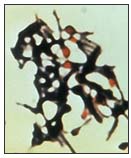Tetanus pathophysiology
|
Tetanus Microchapters |
|
Diagnosis |
|---|
|
Treatment |
|
Case Studies |
|
Tetanus pathophysiology On the Web |
|
American Roentgen Ray Society Images of Tetanus pathophysiology |
|
Risk calculators and risk factors for Tetanus pathophysiology |
Editor-In-Chief: C. Michael Gibson, M.S., M.D. [1]
Overview
The bacteria that causes tetanus, Clostridium tetani is introduced into the human body usually by a wound. The toxins produced by the bacterium, utilize the blood and/or lymphatics to gain access to target tissues. The toxins can act at various places in the central nervous system, including the spinal cord, peripheral motor end plates, and the brain. They can also act on the sympathetic nervous system.
Pathophysiology
Tetanus is caused by an exotoxin from Clostridium tetani that leads to acute, often fatal illness. Generalized, widespread rigidity and skeletal muscle spasms are common presentations of tetanus. The muscle stiffness begins from the jaw (lockjaw) progressing to the neck and then becoming generalized. C. tetani is a terminal spore forming bacteria. The spores is very resistant to extremes of temperature and to the normally used antiseptics. The spores can be found in the soil as well as in the intestines and feces of cattle, dogs, sheep, horses, cats, guinea pigs, rats, and chickens. The soil that has been treated with manure may contain huge amount of spores. Human adults related to agricultural work may also harbor the pathogen.
Pathogenesis
- C. tetani gains access to the human body through a wound.
- The spores germinate, because of their anaerobic character.
- Toxins are produced and spread through the blood and lymphatics.
- C. tetani produces two exotoxins
- Tetanolysin, whose function is not well understood and
- Tetanospasmin which is a neurotoxin and is responsible for the clinical symptoms of tetanus. Tetanospasmin among the most potent toxins with respect to weight.
- The minimum lethal dose for humans, according to an estimate, is around 2.5 nanograms per kg of body weight or 175 nanograms for an individual who weighs 70-kg (154lb).
- The release of various neurotransmitters that cause inhibition is altered by the tetanus toxin.
- This intern leads to an unopposed contraction of the muscles which manifests as a spasm.
- The autonomic nervous system is also targeted leading to a seizure.
Microscopic Pathology
